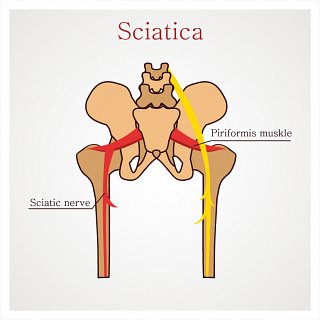Sciatica Stretches
Sciatic Stretches
Discover the cause of your condition first.

When patients come for treatment with a sciatic type pain, I am often asked “Are there any stretches I can do to ease the pain?”
They want to learn some stretches to give some relief to their discomfort, but are often worried they will do more harm than good. And … they are wise to be concerned!
Before I tell you how to stretch your sciatic nerve it is essential to point out that stretches performed on an irritated nerve that is not tight may worsen your sciatica symptoms greatly. It is only rarely that I find a sciatic nerve that requires stretching.
More often, it is the muscles, joints and ligaments that have become tight around the sciatic nerve that causes sciatica. If you are unsure as to the cause of your sciatica, read this article about some of the causes.

If a muscle - through which the sciatic nerve passes - becomes tight, it can pull or compress your sciatic nerve. This causes pain, pins and needles and sometimes numbness.
A common example of muscle tightness compressing the sciatic nerve is the piriformis muscle. This is a muscle deep in your buttocks that often tightens and causes compression to your sciatic nerve - the end result being sciatica. The treatment for this form of sciatica is primarily to stretch and loosen your piriformis muscle.
If, instead, you stretch your sciatic nerve without first releasing the piriformis muscle - your sciatic symptoms may worsen.
If the cause or your sciatica does suggest a nerve that requires stretching it should first be performed under the guidance of a Physiotherapist or other qualified health care professional. This is because nerves are very sensitive to stretching and the appropriate pressure to stretch your nerve needs to be identified carefully. FOllowing this, your therapist will advise you on the frequency and number of nerve stretches to do daily to resolve the tightness in the nerve tissue.
The most common sciatic stretch that I use is as follows:
- Lie on your back with your legs outstretched.
- Elevate one leg to the vertical (or as vertical as your tightened tissues will allow).
- If this is comfortable I then ask you to bend your foot towards you (dorsiflexion).
- If this is comfortable I turn your foot inwards (inversion).
- The duration of the stretch will depend on many individual factors.
Never stretch through pain, pins and needles or numbness.
If your symptoms worsen following a stretch, then stop! It usually suggests an overstretching of the nerve which may be inflamed and irritated. Another treatment may be required before further nerve stretching or sciatica exercises are undertaken.
Always seek medical advice for your sciatica as it usually requires mobilisation and specific treatments to each individual case.
DISCLAIMER
While the content and materials contained in the articles on this website have been written & researched by Sally Ann Quirke, a professional, practising & fully qualified Chartered Physiotherapist (Physical Therapist) based in Ireland, they are provided for general information and educational purposes only. They do not constitute medical advice on any particular individual situation. Please see your Chartered Physiotherapist or other medical practitioner for full and individual consultation.
Please read the full disclaimer here.
Cookies and Privacy
By using this website, you consent to the use of cookies in accordance with our cookie policy. For more information on how we use cookies, please read our cookie policy here.
